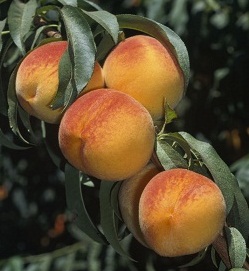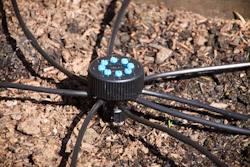Growing Fruit Trees

Growing your own fruit, whether its apples, peaches or pears, requires that you plant your tree in a location where it receives at least 6 hours of sunlight a day during the growing season. Sun, plus regular irrigation are the two keys to successful fruit production. Fruit thinning is also very important because many fruit trees will produce more fruit than their branches can hold, especially when trees are young. Managing pests and diseases and fertilizing are all aspects of growing your own fruit.
Irrigation (watering)

The right amount of water for a given fruit tree depends primarily on two factors: the size of the tree and the heat of the day. Watering the right amount, given these two factors, is the key to fruit tree irrigation. Very generally, fruit trees need a large volume of water, but not every day. While trees do not need to be watered after leaf drop until early spring, you don’t want the soil to dry out if the spring is hot and dry. Detailed irrigation information, including examples of how long to water using different watering methods (drip or sprinkler) can be found at The Home Orchard.
Fertilizing
Until recently, backyard orchards were established without pre-plant fertilization. Maintenance fertilizers, usually nitrogen (N), were applied after trees are established. Nitrogen and potassium (K) are the most commonly needed fertilizers for fruit trees. Specialized fruit tree fertilizers can be purchased at nurseries. Be sure to follow all instructions. Do not add more fertilizer to help your tree “grow faster” – any extra fertilizer could either damage your tree or get washed away into the storm drain system. Detailed fertilizing instructions, including what to do first year after planting, can be found here at The Home Orchard.
Fruit Thinning
Fruit trees often produce more fruit than the branches can hold when young, and more fruit than the tree can support as it matures. Thinning fruit or removing extra fruit when the fruit is small is key to harvesting good sized fruit. Each type of tree has an ideal fruit to leaf ratio, somewhere between 40 and 75 leaves per fruit to reach “full” size. Detailed instructions can be found here at The Home Orchard.
Pests and Diseases
“Integrated Pest Management (IPM) is a method of encouraging natural predators to control pests in your garden or orchard. Nature provides a balance between plant pests and the beneficial insects that control these pests. The less we do to tamper with that balance, the more likely it is to work successfully” (UC Backyard Orchard Pests & Diseases web page). Ideally you want to prevent problems by choosing a good site for your tree, watering the correct amount and addressing problems by choosing the least toxic method first. Additional information can be found here: Reduce Pests and Diseases By Changing Your Cultural Practices
Further Reading on Growing Fruit Trees
For detailed information, start here: http://homeorchard.ucdavis.edu/The_Big_Picture/Pests_&_Diseases/
For specific issues by variety, check here: http://www.ipm.ucdavis.edu/PMG/GARDEN/fruit.html
For a yearly calendar, check here: http://homeorchard.ucdavis.edu/calendar.pdf
Suggested book: http://www.ipm.ucdavis.edu/IPMPROJECT/ADS/manual_gardenfarms.html

